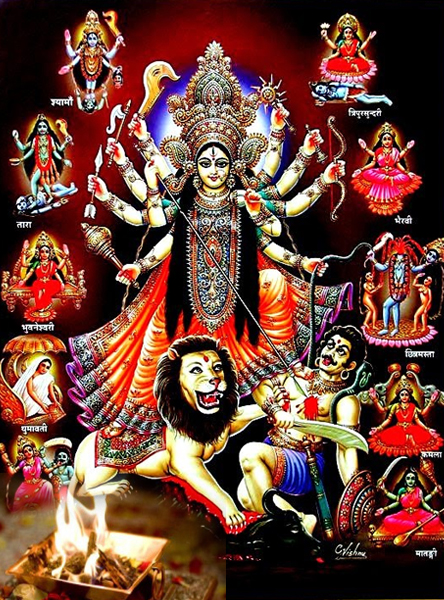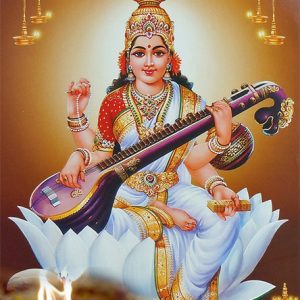Description
The Ten Mahavidyas are known as Wisdom Goddesses. The spectrum of these ten Goddesses covers the whole range of feminine divinity, encompassing horrific Goddess’s at one end, to the ravishingly beautiful at the other. Mahavidya means (Maha – great; vidya – knowledge) Goddesses of great knowledge. These Goddesses are: Mahavidyas – The ten forms of Shakti
- Kali – the Eternal Night
- Tara the – Compassionate Goddess
- Shodashi – the Goddess who is Sixteen Years Old
- Bhuvaneshvari – the Creator of the World
- Chinnamasta – the Goddess who cuts off her Own Head
- Bhairavi – the Goddess of Decay
- Dhumawati – the Goddess who widows Herself
- Bagalamukhi – the Goddess who seizes the Tongue
- Matangi – the Goddess who Loves Pollution
- Kamala – the Last but Not the Least
The worship of Dasmahavidya provides bhoga (fulfillment of materialisitic desires) and moksha (spiritual liberation).
Birth of Das Mahavidyas: Once during their numerous love games, things got out of hand between Shiva and Parvati. What had started in jest turned into a serious matter with an incensed Shiva threatening to walk out on Parvati. No amount of coaxing or cajoling by Parvati could reverse matters. Left with no choice, Parvati multiplied herself into ten different forms for each of the ten directions. Thus however hard Shiva might try to escape from his beloved Parvati, he would find her standing as a guardian, guarding all escape routes.
Each of the Devi’s manifested forms made Shiva realize essential truths, made him aware of the eternal nature of their mutual love and most significantly established for always in the cannons of Indian thought the Goddess’s superiority over her male counterpart. Not that Shiva in any way felt belittled by this awareness, only spiritually awakened. This is true as much for this Great Lord as for us ordinary mortals. Befittingly thus they are referred to as the Great Goddess’s of Wisdom, known in Sanskrit as the Mahavidyas. Indeed in the process of spiritual learning the Goddess is the muse who guides and inspires us. She is the high priestess who unfolds the inner truths.
Puja service includes: Sthapana (Ganesh, Devi, Navgraha Kalash, Brahma), Swasti Vachan, Sankalp, Ganesh Pujan, Navgraha Puja, Invocation of major Gods, Brahman Varn, Das Mahavidya yantra Pujan, 11000 mantra jaap of each goddess, 7 or 11 Kavach recitations of each goddess, after completion of each devi mantra Havan with 108 Ahutis to each goddess is performed, Ahutis to (Navgrahas, Ganesh, 64 yogini, Shetrapal, Putusukt, Devi Sukt, Rudra Sukt), Donation food to brahmins.
Number of priests: 5
Duration: 10 days, 6 hours daily
Vedic Anushthan priests will perform Puja & yagna as per vedic rituals based on birth details. The Puja prasad, energised Rudraksha and photos will be sent to you through courier. Please mention your birth details (name, date, time, place) Sankalp (wish) at checkout. This is a individual yagna (you may do puja on individual name or include your near and dear ones in the puja). You will be provided with the contact no. of the priest, to call during the sankalpa/yagna.





